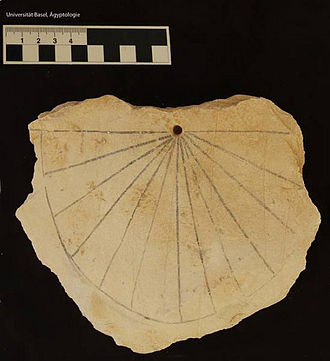Sundial
Sundial is a device that tells the time by using the position of the Sun. It consists of a flat plate (the dial) and a gnomon, which is a thin rod or a triangular blade that casts a shadow. Sundials are among the oldest known devices for time measurement, predating more complex mechanical clocks. The principle behind a sundial is simple: as the Sun moves across the sky, the shadow cast by the gnomon moves around the dial, indicating the time of day. Sundials must be aligned with the Earth's rotational axis to be accurate, with the gnomon pointing towards true north in the northern hemisphere and true south in the southern hemisphere.
History
The history of the sundial dates back to ancient civilizations, with evidence of its use in Ancient Egypt, Ancient Greece, and Roman times. The earliest sundials were simple vertical plates or plinths that tracked the Sun's shadow. Over centuries, sundials became more sophisticated, incorporating mathematical advancements and becoming more accurate and ornamental.
Types of Sundials
There are several types of sundials, each designed for different uses and latitudes:
- Horizontal Sundials: The most common type, placed horizontally and suitable for use in mid-latitudes.
- Vertical Sundials: Mounted on walls, these sundials can be oriented in any cardinal direction, though south-facing dials are most common in the northern hemisphere.
- Equatorial Sundials: The dial plate is parallel to the equator, allowing the gnomon to be aligned with the Earth's axis. This type is accurate year-round.
- Polar Sundials: The dial plate is aligned parallel to the gnomon, which points to the celestial pole, making the dial's face perpendicular to the Earth's axis.
- Analemmatic Sundials: A horizontal sundial with a movable gnomon that the user must adjust throughout the year.
Reading a Sundial
To read a sundial, one must understand the sundial's local solar time, which can differ from standard time zones and daylight saving time. The shadow's edge closest to the gnomon indicates the time. Some sundials include corrections for the equation of time, a term that describes the discrepancy between solar time and clock time.
Mathematics and Geometry
The design of a sundial involves intricate mathematics and geometry, particularly in calculating the angle of the gnomon and the placement of hour lines. The angle at which the gnomon is set corresponds to the latitude of the sundial's location. The hour lines are laid out according to the path of the Sun as observed from that latitude.
Cultural Significance
Beyond their practical use, sundials have held significant cultural and symbolic meanings. They have been used as metaphors for the passage of time and the transient nature of life in literature and art. Sundials often bear inscriptions that reflect on mortality and the importance of time.
Modern Use
While modern technology has largely supplanted sundials for practical timekeeping, they remain objects of educational interest, historical importance, and aesthetic value. Sundials are found in gardens, public parks, and at astronomical observatories, serving as reminders of humanity's long fascination with time and the cosmos.
Transform your life with W8MD's budget GLP-1 injections from $125.
W8MD offers a medical weight loss program to lose weight in Philadelphia. Our physician-supervised medical weight loss provides:
- Most insurances accepted or discounted self-pay rates. We will obtain insurance prior authorizations if needed.
- Generic GLP1 weight loss injections from $125 for the starting dose.
- Also offer prescription weight loss medications including Phentermine, Qsymia, Diethylpropion, Contrave etc.
NYC weight loss doctor appointments
Start your NYC weight loss journey today at our NYC medical weight loss and Philadelphia medical weight loss clinics.
- Call 718-946-5500 to lose weight in NYC or for medical weight loss in Philadelphia 215-676-2334.
- Tags:NYC medical weight loss, Philadelphia lose weight Zepbound NYC, Budget GLP1 weight loss injections, Wegovy Philadelphia, Wegovy NYC, Philadelphia medical weight loss, Brookly weight loss and Wegovy NYC
|
WikiMD's Wellness Encyclopedia |
| Let Food Be Thy Medicine Medicine Thy Food - Hippocrates |
Medical Disclaimer: WikiMD is not a substitute for professional medical advice. The information on WikiMD is provided as an information resource only, may be incorrect, outdated or misleading, and is not to be used or relied on for any diagnostic or treatment purposes. Please consult your health care provider before making any healthcare decisions or for guidance about a specific medical condition. WikiMD expressly disclaims responsibility, and shall have no liability, for any damages, loss, injury, or liability whatsoever suffered as a result of your reliance on the information contained in this site. By visiting this site you agree to the foregoing terms and conditions, which may from time to time be changed or supplemented by WikiMD. If you do not agree to the foregoing terms and conditions, you should not enter or use this site. See full disclaimer.
Credits:Most images are courtesy of Wikimedia commons, and templates, categories Wikipedia, licensed under CC BY SA or similar.
Contributors: Prab R. Tumpati, MD






